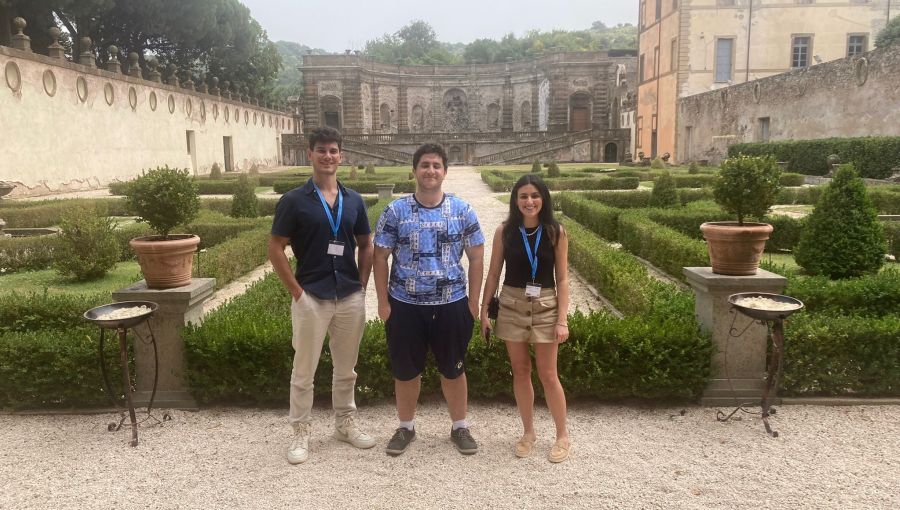Creative Wildfire: Meet MA in Art History Alumna Myca Treat
Originally from a small town in Arkansas, alumna Myca Treat graduated from JCU with an MA in Art History in Spring 2024. Before coming to JCU, Myca received a bachelor’s degree in Studio/Fine Arts (with an emphasis in oil painting) and a minor in Art History from Hendrix College in Conway, Arkansas.

Tell us about your background.
I’ve been told I was making art since the moment I could hold a pencil. Family vacations always featured detours to art museums at my insistence and my high school career was entirely shaped by how many art classes I could take and how many art conferences I could attend. In my senior year of high school, I enrolled in the single art history course my high school offered and something ignited in me. During my freshman year of undergrad at Hendrix College, I took a course on Italian Renaissance and Baroque Art History and, through a sponsored trip, was given an opportunity to go to Florence, Italy, for a week in the summer of 2018. After that class and summer trip, the spark ignited by my high school art history course was now a full forest fire.
How did you find out about JCU’s MA in Art History and what made you decide to apply? How did the program enrich you?
After graduating from Hendrix College in the Spring of 2021, I knew graduate school for art history was my next step, but I wasn’t sure where that would lead me. I decided to take a gap year while I worked and applied for graduate schools. What brought me to JCU was, ultimately, my dissatisfaction with art history programs in the States and an online article about art history master’s programs abroad. Admittedly, I applied on a whim but I will never regret that impulsive application. Alongside meeting many incredible professors and colleagues, the charm of JCU’s Art History master’s program is mainly due to its location in the heart of Rome. My art historical knowledge has been immeasurably enriched by the knowledge of the professors, fellow students, and the city itself.
How did you become passionate about Art History?
As I mentioned, I have always favored artistic pursuits. Maybe it’s in my blood because my mother was a professional photographer, and her great-grandmother was a painter, and that creative craving was passed down to me. However, toward the end of my undergraduate career, I realized I had no interest in pursuing a career as a professional artist. As much as I loved oil and graphite, I discovered that I cared much more about the how, the why, and all those minute influences that shape the production of art. I had no desire to be in the spotlight as the maker but, rather, I was content to simply think about art. Though I loved being in the studio covered in oil paint, I had more fun sitting in the library pouring over books while writing papers for my art history classes. Realizing I could make art privately while pursuing art history academically was pivotal. Additionally, my route through academic art history has been shaped by the teachers and professors I have been guided by. From high school through graduate school, teachers passionate about art history have only increased my passion for the subject.
Tell us about your thesis Performing with Water: Voyage of the Viewer in Roman Water Gardens.
Though I went into the program knowing I would, hopefully, pursue something in the realm of ancient art, my flourishing love of antiquity is entirely thanks to Professor Inge Hansen. Professor Hansen and her course Public and Private Space reshaped and renewed how I think about Antiquity, and I am immensely grateful to her for being my primary thesis reader. My thesis, Performing with Water: Voyage of the Viewer in Roman Water Gardens, was the expanded research paper for Public and Private Space which I took in the Fall 2022 semester. Essentially, I was interested in investigating the performative manipulation of water in the grotto of Sperlonga (in the Lazio region of Italy) and the Canopus of Hadrian’s Villa and how water, within those spaces, becomes an influential and ornamental element of intentional curation. The body of my thesis was broken down into the performative engagement afforded by the respective sculptural displays, 2nd-century spatial curation, and, lastly, the role of water in the water gardens of Sperlonga and Tivoli. I am grateful to Professor Hansen for her guidance, which kept me on track and helped me hone the ideas that were, simply, too much to tackle in the span of two semesters. That is, I think, the most surprising thing that I learned: I still have so much I could say and there is so much more research that can be done on the role of water as an element of spatial and personal curation during the 2nd century.
What are your plans for the future?
My time as a Teaching Assistant for Professor Hansen’s undergraduate course on Art Historical Thinking really opened my eyes to the possibilities of teaching and that is an idea I am keeping in the back of my mind as I move forward. Currently I am starting the process of finding a job and, eventually, pursuing a Ph.D. in Art History, as I don’t think I am quite ready to step back from academia.





